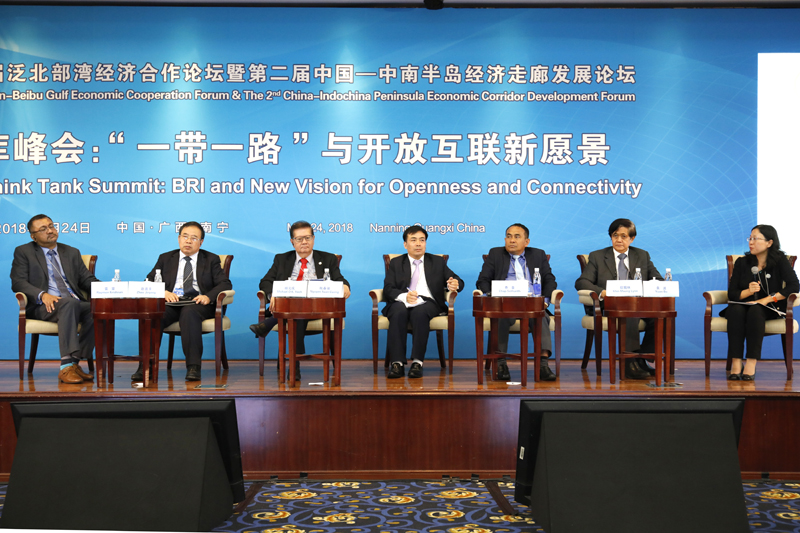Information

Date: May 24, 2018
Venue: International Conference Center, Liyuan Resort, Nanning, China
Host: The People’s Government of Guagnxi Zhuang Autonomous Region and CDI
Theme: Belt and Road Initiative and New Vision for Openness and Connectivity
Program
09:00-10:30 Opening Ceremony
10:40-12:30 Plenary Session
14:00-18:00 Parallel Sessions
18:30-20:00 Closing Reception
Parallel Session: Pan-Beibu Gulf Think Tank Summit
14:00-14:15 Opening Remarks
HUANG Junhua, Vice Chairman, People's Government of the Guangxi Zhuang Autonomous Region, China
Moderator:
GUO Wanda, Executive Vice President, China Development Institute
14:15-15:50 Joint Development of Overland and Sea Routes
The southern transport corridor, which links to Silk Road Economic Belt in the north and 21st Century Maritime Silk Road in the south, is set to boost connectivity between China and Southeast Asia. The session discusses how to drive economic growth by improving the joint development of the overland and sea routes and how to inject vitality into China-ASEAN strategic cooperation so as to bring concrete benefits to people.
Moderator:
YUAN Bo, Deputy Director, Department of ASEAN and South Asian Studies, Institute of Asian and African Studies, Chinese Academy of International Trade and Economic Cooperation, MOFCOM
Panelists:
Raymon KRISHNAN, Director of Corporate Advisory, Asian Trade Centre, Singapore
ZHAO Jinping, Director-General of the Research Department of Foreign Economic Relations, Development Research Center of the State Council, China
Michael O.K. YEOH, Chief Executive Officer, Asian Strategy and Leadership Institute, Malaysia
NGUYEN Xuan Cuong, Director, Institute of Chinese Studies, Vietnam Academy of Social Sciences
Chap SOTHARITH, Research Director and Board Member, Cambodian Institute for Cooperation and Peace
KHIN Maung Lynn, Joint Secretary, Myanmar Institute of Strategic and International Studies
(10 min for each speaker, 30 min for Q&A)
15:50-16:05 Coffee Break
16:05-17:40 Transformation and Upgrading of Regional Cooperation
China and the ASEAN countries are committed to sustainable economic and social development driven by innovation. The session discusses how to promote transformation and upgrading of regional cooperation in the context of Belt and Road Initiative and how to strengthen cooperation on emerging industries and nature new growth engine.
Moderator:
HE Liping, Professor and Head of the Research Center of International Finance, School of Economics and Business, Beijing Normal University, China
Panelists:
Nipon POAPONGSAKORN, Distinguished Fellow and Former President, Thailand Development Research Institute
Fajar HIRAWAN, Senior Researcher, Department of Economics, Center for Strategic and International Studies, Indonesia
YE Fujing, Director, Institute of International Economic Research, Chinese Academy of Macroeconomic Research
Bouadam SENGKHAMKHOUTLAVONG, Director, Asian Research Center, National University of Laos
Maragtas AMANTE, Professor, School of Labor and Industrial Relations, University of the Philippines Diliman
FAN Zuojun, Vice President, Guangxi University, China
(10 min for each speaker, 30 min for Q&A)
17:40-17:50 Closing Remarks
GUO Wanda, Executive Vice President, China Development Institute
Highlights
In recent years, China and ASEAN have strengthened political mutual trust, and yielded fruitful results in pragmatic cooperation in all directions, at various levels and in a wide range of fields. Both sides have actively promoted the construction of a comprehensive connectivity model and realized the transformation of regional cooperation, which is conducive to China-ASEAN cooperation.
The Belt and Road Initiative provides an important cooperation platform for the upgrading of China-ASEAN relations.
ASEAN is a key region and area of interest for BRI construction, with numerous cooperation projects underway. The construction of a tighter China-ASEAN community with shared future will bring valuable opportunities for the development of both sides.
BRI has promoted connectivity between China and ASEAN member countries.
Many ASEAN member countries are in need of substantial infrastructure investment, which requires a diversified investment and financing mechanism. As important financial supporters of BRI, Asian Infrastructure Investment Bank (AIIB) and Silk Road Fund can meet the financing needs of ASEAN countries, and can also optimize cost sharing mechanism and avoid various risks of cross-border construction.
With the development of BRI construction, there will be more personnel, and cultural and educational exchanges between China and ASEAN countries, which will facilitate understanding between the two sides.
China and ASEAN countries should strengthen connectivity and promote the transformation of regional cooperation
First of all, infrastructure connectivity is a key factor in promoting mutually beneficial cooperation between China and ASEAN countries. The China-Indochina Economic Corridor, a transnational economic corridor between China and ASEAN, still faces backward infrastructure development in land-sea connectivity. The two sides should further strengthen intergovernmental communication, and enhance institutional cooperation, e.g. establishing an infrastructure construction committee, in order to facilitate land-sea connectivity policy communication. On the other hand, both sides should be committed to building a multi-level financing system through the cooperation of various financial institutions and innovate investment and financing methods in order to establish a new diversified investment and financing model that can mobilize the effective participation of public and private sectors, providing diversified financing arrangements for infrastructure projects along the BRI.
In addition, optimizing cooperation mechanism will promote regional economic transformation and upgrading. First, establish new institutional arrangements, such as trade facilitation, elimination of border trade barriers, and optimization of trade structure, to promote China-ASEAN regional economic integration and achieve inclusive growth. Second, strengthen coordination of regional cooperation mechanisms among the Lancang-Mekong Cooperation, Great Mekong Subregion Cooperation, and China-Indochina Peninsula Cooperation, to avoid redundant construction and waste of resources. Third, promote the cooperation of emerging industries between China and ASEAN and increase R&D budgets for innovation through policy communication between the two sides in order to strengthen economic relations between China and ASEAN.
Give full play to China and ASEAN think tanks’ role of "intellectual support" and "people-to-people connectivity"
The exchange and cooperation between China and ASEAN think tanks is an important part of BRI. Think tank’s in-depth research reports are crucial for the materialization of BRI projects. Its support on regional planning, policy research, mechanism design will facilitate China-ASEAN cooperation.
Looking forward, China and ASEAN think tanks should serve as a bridge between the government and the public to promote people-to-people connectivity in areas such as policy communication and academic research, expanding the consensus while narrowing the cognitive gap between the countries.
Photos
https://en.cdi.org.cn/component/k2/item/436-pan-beibu-gulf-think-tank-summit#sigProId353eb9eb92










